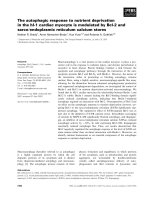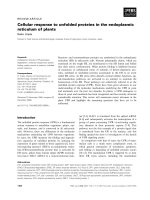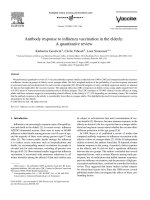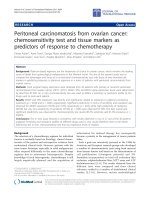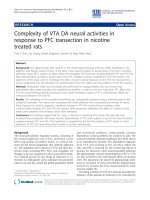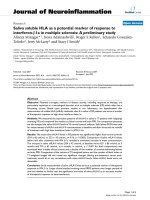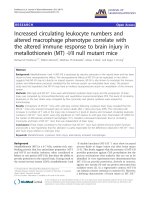VEGF-121 plasma level as biomarker for response to anti-angiogenetic therapy in recurrent glioblastoma
Bạn đang xem bản rút gọn của tài liệu. Xem và tải ngay bản đầy đủ của tài liệu tại đây (756.08 KB, 7 trang )
Martini et al. BMC Cancer (2018) 18:553
/>
RESEARCH ARTICLE
Open Access
VEGF-121 plasma level as biomarker for
response to anti-angiogenetic therapy in
recurrent glioblastoma
Maurizio Martini1, Ivana de Pascalis2, Quintino Giorgio D’Alessandris2, Vincenzo Fiorentino1, Francesco Pierconti1,
Hany El-Sayed Marei3, Lucia Ricci-Vitiani4, Roberto Pallini2 and Luigi Maria Larocca1*
Abstract
Background: Vascular endothelial growth factor (VEGF) isoforms, particularly the diffusible VEGF-121, could play a
major role in the response of recurrent glioblastoma (GB) to anti-angiogenetic treatment with bevacizumab. We
hypothesized that circulating VEGF-121 may reduce the amount of bevacizumab available to target the heavier
isoforms of VEGF, which are the most clinically relevant.
Methods: We assessed the plasma level of VEGF-121 in a brain xenograft model, in human healthy controls, and in
patients suffering from recurrent GB before and after bevacizumab treatment. Data were matched with patients’
clinical outcome.
Results: In athymic rats with U87MG brain xenografts, the level of plasma VEGF-121 relates with tumor volume and
it significantly decreases after iv infusion of bevacizumab. Patients with recurrent GB show higher plasma VEGF-121
than healthy controls (p = 0.0002) and treatment with bevacizumab remarkably reduced the expression of VEGF-121
in plasma of these patients (p = 0.0002). Higher plasma level of VEGF-121 was significantly associated to worse PFS
and OS (p = 0.0295 and p = 0.0246, respectively).
Conclusions: Quantitative analysis of VEGF-121 isoform in the plasma of patients with recurrent GB could be a
promising predictor of response to anti-angiogenetic treatment.
Keywords: Recurrent glioblastoma, Antiangiogenetic-therapy, VEGF isoforms, Target therapy
Background
Glioblastoma (GB) is one of the most vascularized
human tumors and the abnormal microvascular proliferation, in particular of the so-called glomeruloid vessels,
represents a histopathological hallmark of this neoplasia
[1, 2]. Hypoxia is a major driving force of this process
that determines a consistent upregulation of several
proangiogenic factors [3]. Among them, vascular endothelial growth factor-A (VEGF-A, commonly referred to
as VEGF) seems to be the most important one, mainly
* Correspondence:
Roberto Pallini and Luigi Maria Larocca are shared the senior authorship.
Maurizio Martini and Ivana de Pascalis are equally contributed to the
manuscript.
1
Polo Scienze Oncologiche ed Ematologiche, Istituto di Anatomia Patologica,
Università Cattolica del Sacro Cuore, Fondazione Policlinico Universitario
Agostino Gemelli, Largo Francesco Vito 1, 00168 Rome, Italy
Full list of author information is available at the end of the article
operating in the activation of quiescent endothelial cells
and promoting cell migration and proliferation [2–5].
As GBs are highly vascularized cancers with high levels
of VEGF, therapies that target angiogenesis have generated
substantial interest [6]. In this regard, a humanized antiVEGF monoclonal antibody, called bevacizumab, has
recently been approved for the therapy of recurrent GB
[6–9]. However, the initial optimism generated by the
therapeutic results in the recurrent setting was tempered
by recent Phase III trials showing no efficacy for treating
newly diagnosed GBs [6, 10, 11]. This data, together with
the clinical evidence that a significant percentage of GBs
treated with bevacizumab for an extended period of time
undergoes transformation to a more biologically aggressive tumor, leads to uncertainty about the appropriate
indications for the use of bevacizumab in GB [12, 13].
Despite these concerns, there remain numerous examples
© The Author(s). 2018 Open Access This article is distributed under the terms of the Creative Commons Attribution 4.0
International License ( which permits unrestricted use, distribution, and
reproduction in any medium, provided you give appropriate credit to the original author(s) and the source, provide a link to
the Creative Commons license, and indicate if changes were made. The Creative Commons Public Domain Dedication waiver
( applies to the data made available in this article, unless otherwise stated.
Martini et al. BMC Cancer (2018) 18:553
of radiological and clinical improvement after antiangiogenetic treatment in de novo GB and particularly in
patients with recurrent GB with limited therapeutic options. For this reason, the search for predictive biomarkers
able to identify those patients who will likely benefit from
bevacizumab is a primary focus in the assessment of antiangiogenic therapy for GB [12, 14, 15].
VEGF exists in several isoforms with different
molecular weights and biological properties. Heavier
isoforms (VEGF-206, VEGF-189) are bound to the
extracellular matrix and represent a reserve of VEGF
[16, 17]. The intermediate-weight VEGF-165 isoform
has an optimal bioavailability and high mitogenic
potential. On the contrary, the lighter VEGF-121 isoform, the main one present in circulating blood, has
low mitogenic potential and probably plays a minor
role in tumor angiogenesis [16–18].
We have recently shown that GB is able to produce all
VEGF isoforms and that its sensitivity to bevacizumab
may depend on the relative amount of the various isoforms [19]. As bevacizumab binds to all VEGF isoforms,
we postulated that in patients with low levels of circulating VEGF-121 a greater amount of bevacizumab may be
available to target the heavier and intermediate isoforms
of VEGF, which are the most clinically relevant [19, 20].
In the present study, we used a brain xenograft model of
human GB cells to demonstrate that the VEGF-121 isoform can be readily detectable in the peripheral blood,
that its plasma levels relate with tumor size, and that
circulating VEGF-121 significantly decreases after bevacizumab infusion. Then, we analyzed a group of patients
with recurrent GB under treatment with anti-angiogenic
therapy and showed a significant reduction of plasma
VEGF-121 after bevacizumab infusion. Notably, patients
with baseline lower levels of VEGF-121 and lower reduction of VEGF-121 after anti-angiogenetic drug infusion
showed a better clinical outcome suggesting that levels of
circulating VEGF-121 could represent a useful biomarker
to predict the efficacy of bevacizumab in GB patients.
Methods
Intracranial xenografting of human GB cells in athymic
rats and blood sampling
Experiments involving animals were approved by the
Ethical Committee of the Università Cattolica Sacro
Cuore (UCSC), Rome (Pr. No. CESA/P/51/2012).
Immunosuppressed athymic rats (n. 10; male, 250-280 g;
Charles River, Milan, Italy) were anesthetized with intraperitoneal injection of diazepam (2 mg/100 g) followed
by intramuscular injection of ketamine (4 mg/100 g).
Animal skulls were immobilized in a stereotactic head
frame and a burr hole was made 3 mm right of the midline and 1 mm anterior to the bregma. The tip of a
10 μl-Hamilton microsyringe was placed at a depth of
Page 2 of 7
5 mm from the dura and 2 × 104 U87MG cells were
slowly injected. After grafting, the animals were kept
under pathogen-free conditions in positive-pressure
cabinets (Tecniplast Gazzada, Varese, Italy) and
observed daily for neurological signs. Beginning 4 days
after implantation, the rats were treated with bevacizumab (10 mg/kg ip) twice weekly. Control animals were
treated with equal volumes of saline. After 28 days of
survival, the rats were deeply anesthetized. The aorta
was transcardially cannulated and 1.5 ml of blood was
taken into a syringe with EDTA as anticoagulant. Then,
rats were perfused with saline followed by 4% paraformaldehyde in 0.1 M PBS. The brain was removed, stored
in 30% sucrose buffer overnight at 4 °C, and serially
cryotomed at 40 μm on the coronal plane. Sections were
collected in distilled water, mounted on slides, and
stained with cresyl violet. Tumor volumes (in 8 rats)
were calculated on histological sections through the
tumor epicenter, according to the equation: V = (a2 x b)/
2, where a is the shortest diameter and b is the longest
diameter of tumors.
Patients and bevacizumab treatment
The study was conducted on three groups of patients.
The first group (n, 6) was composed of patients suffering
from recurrent GB after having undergone surgery and
standard-of-care chemo-radiotherapy (Stupp protocol)
[21], who were not eligible for reoperation and received
bevacizumab therapy (5 men and 1 woman, aged 45 to
66 years at the time of primary surgery, median age of
55.5 years). The second group (n, 6) was composed of
patients that completed the Stupp protocol, who showed
recurrent tumor on follow-up Magnetic Resonance
Imaging (MRI), who were judged eligible for reoperation
and did not receive bevacizumab (4 men and 2 women,
aged 48 to 76 years at the time of primary surgery, a median age of 59.6 years) (see Table 1). The third group
was composed of 10 healthy volunteers who did not receive bevacizumab (7 men and 3 women, aged 50 to
73 years at the time of the analysis, median age of 58.
2 years). Treatment of the first group involved the administration of bevacizumab at the dose of 10 mg/kg iv
every 2 weeks in 6-week cycles. Immediately before and
30 min after the end of bevacizumab infusion, plasma
samples were collected for VEGF-121 analysis. All patients provided written informed consent according to
the research proposals approved by the Ethical Committee of the UCSC. Response to treatment was classified
using RANO criteria [19]. In each patient, the contrast
enhancing tumor (CE) area was calculated on follow-up
gadolinium-enhanced T1-weighted MRI in the axial,
coronal, and sagittal planes using ImageJ 1.45S software
(Rasband, W.S., ImageJ, US NIH, Bethesda, Maryland,
USA, 1997-201). Progression-free
Martini et al. BMC Cancer (2018) 18:553
Page 3 of 7
survival (PFS) and overall survival (OS) were defined as
the time between bevacizumab treatment initiation and,
respectively, first documentation of progression or death
from any cause.
Enzyme-linked immunosorbent assay
Peripheral blood samples were collected in tube with
EDTA as anticoagulant. The plasma samples were centrifuged for 15 min at 1000×g at 4 °C, then plasma was
separated and stored in aliquot at − 80 °C until use.
Plasma levels of VEGF-121 were quantified using
Enzyme-linked immunosorbent assay (ELISA) kit for
human-VEGF-121 (SEB851Hu, Cloud-Clone Corp,
Huston, TX) according to the manufacturer’s instruction.
Quantification was performed spectrophotometrically
using LD400, Beckman Coulter (Fullerton, CA) at wavelength of 450 nm. The concentration of VEGF-121 was
determined by comparing the optical density (OD) of
the samples to the standard curve. The minimum
detectable level of VEGF-121 of this kit is typically less
than 6.7 pg/ml.
VEGF-121 mRNA expression in primary GB
The expression of VEGF-121 mRNA was performed as
previously described on cultured T98G, U251, and
U87MG GB cell lines as well as on the tumor tissue of
patients enrolled in this study [19].
Statistical analysis
Statistical analysis was described in Additional file 1.
Results
Plasma VEGF-121 in rats with intracranial xenografts of
human U87MG cells
Recently, we found that GB produces different VEGF
isoforms and that the clinical and radiological response
to bevacizumab is associated with low expression of
VEGF-121 mRNA by the tumor tissue [19]. In order to
test the hypothesis that antigen-antibody reactions
between circulating VEGF-121 protein and infused bevacizumab might reduce the bioavailability of bevacizumab
for the heavier VEGF isoforms, we grafted human
U87MG cells onto the brain of athymic rats and
measured VEGF-121 protein levels in the rat plasma.
We used U87cell line for xenograft experiments because
this cell line expresses several VEGF isoforms and, in
comparison to other glioma cell line, highest level of
VEGF-121 (data not shown) [22]. Human VEGF-121
protein was not detectable in the plasma of normal control rats. In rats with U87MG brain xenografts, however,
plasma VEGF-121 protein was 55.158 ± 38.38 pg/ml
(mean ± sd). The level of VEGF-121 protein in plasma
related significantly with the size of tumor xenografts
(linear regression, r2 = 0.9450; p = 0.0001; Fig. 1a).
Importantly, after injection of bevacizumab in the tail
vein of rats with U87MG brain xenografts, the level of
plasma VEGF-121 protein decreased to 20.918 ± 2.32 pg/
ml (p = 0.0004 Mann-Whitney t test; Fig. 1b). Then, this
experiment demonstrated that VEGF-121 protein can be
measured in plasma and that its level decreases significantly after infusion of bevacizumab.
Expression of plasma VEGF-121 protein in patients with
recurrent GB
We first assessed VEGF-121 protein level in plasma of
healthy volunteers (n, 10), where we detected values of
66.789 ± 17.431 pg/ml (mean ± sd). In plasma of patients
with recurrent GB (n, 12), however, the level of this
isoform was about three folds higher (206.321 ± 35.
693 pg/ml; p = 0.0002; Mann-Whitney t test; Fig. 2a).
Moreover, patients with higher plasma level of VEGF121 also had higher expression of mRNA of this isoform
in the tumor tissue obtained at surgery with a significant
relationship between the two variables (linear regression,
Table 1 Patients’ characteristics and clinical features
N surgeries pre-bev
n bev cycles
Patient
Tumor location
Best response
Toxicity (grade)
PFS (mos)
OS (mos)
1
R temporal
3
11
CR
none
51
71
2
R parietal
1
12
CR
none
36
41
3
R temporal
1
1
PD
brain hemorrhage
3
4
4
R parietal
2
2
SD
hepatic failure
6
8
5
L temporal
1
9
CR
none
40
48
6
multifocal
1
2
PD
brain hemorrhage
6
7
7
L occipital
1
NA
NA
NA
NA
NA
8
multifocal
1
NA
NA
NA
NA
NA
9
L parietal
2
NA
NA
NA
NA
NA
10
R parietal
1
NA
NA
NA
NA
NA
11
R temporal
1
NA
NA
NA
NA
NA
12
L parietal
1
NA
NA
NA
NA
NA
Martini et al. BMC Cancer (2018) 18:553
Page 4 of 7
Fig. 1 a The panel shows the significant correlation between the size of tumor and the VEGF-121 plasma level in the xenografts (linear regression,
r2 = 0.9450; p = 0.0001); b. The panel shows the significant reduction of the human VEGF-121 plasma level in rats harboring intracranial xenografts
of human GB U87MG cell line, between controls and bevacizumab-treated animals (p = 0.0004 Mann-Whitney t test t)
Fig. 2 a. The figure shows the significantly higher expression of VEGF-121 in the plasma of patients with recurrent GB (Pre-BEV) in comparison to
the healthy patients (HC) (p = 0.0002, Mann-Whitney t test). After bevacizumab treatment (Post-BEV) patients with recurrent GB showed a significant
reduction of the human VEGF-121 plasma level (p = 0.0002, Mann-Whitney t test); b. The figure shows the significant correlation between plasma level
of VEGF-121 and cancer tissue VEGF-121 mRNA expression (linear regression, r2 = 0.9447, p = 0.0001); c. The figure shows the significant correlation
between plasma level of VEGF-121 and contrast enhancing tumor area (linear regression, r2 = 0.8248, p = 0.0003)
Martini et al. BMC Cancer (2018) 18:553
r2 = 0.9447, p = 0.0001; Fig. 2b). After iv infusion of
bevacizumab, the level of VEGF-121 in the plasma of
GB patients lowered (n, 6; 115.076 ± 12.746 pg/ml) with
a significant reduction in comparison to pre-infusion
level (p = 0.0002 Mann-Whitney t test; Fig. 2a). Despite
its drop after iv bevacizumab, VEGF-121 plasma level
remained significantly higher than healthy volunteers (p
= 0.0022 Mann-Whitney t test; Fig. 2a). Interestingly,
when we correlated the contrast enhancing (CE) tumor
area with the VEGF-121 plasma level measured before
infusion of bevacizumab, we found a linear correlation
where tumors with larger CE area showed higher plasma
level of VEGF-121 (linear regression, r2 = 0.8248, p = 0.
0003; Fig. 2c). When we compare recurrent GB patients
with higher VEGF-121 plasma level before the bevacizumab treatment (greater than the median value > 211.
735 pg/ml) with patients with lower level of VEGF-121
(lower that the median value), we found a significant association between lower level of this VEGF isoform and
a better prognosis (OS, p = 0.0246; HR 15.34; 95% CI
from 1.418 to 166.0; PFS, p = 0.0295; HR 16.23; 95% CI
from 1.320 to 199.6; Fig. 3). Finally, by relating PFS and
OS either to baseline VEGF-121 plasma level or to differential VEGF-121 (ΔVEGF121 = VEGF-121 level at
baseline – VEGF-121 level after bevacizumab infusion),
we observed that higher level of baseline VEGF-121 and
higher ΔVEGF121 were significantly associated with
worse PFS and OS (p = 0.0001 and 0.0003, and p = 0.
0013 and 0.0008, respectively; linear regression test;
Additional file 2: Figure S1).
Discussion
In the search for molecular mechanisms that may underlie the response of recurrent GB to anti-VEGF treatment, we have recently found that this tumor is able to
produce different VEGF isoforms and that better clinical
responses to bevacizumab are significantly associated
with low levels of VEGF-121 mRNA in the tumor
Page 5 of 7
[19]. We hypothesized that this circulating isoform of
VEGF could interfere with the availability of bevacizumab in neutralizing heavier and intermediate isoforms
of VEGF, which play a major role in brain tumor
angiogenesis [19, 22]. Here, we showed that the human VEFG-121 isoform can be detected in plasma of
rats harboring intracranial graft of human U87MG
GB cells, and that following iv infusion of bevacizumab plasma VEGF-121 is significantly lowered. In
patients with recurrent GB, we also demonstrated a
significant association between level of VEGF-121
mRNA in the tumor and VEGF-121 protein level in
plasma. Indeed, these patients have three-fold higher
level of plasma VEGF-121 protein compared to
healthy controls. Consistent with the in vivo findings,
VEGF-121 plasma level significantly decreased after
bevacizumab infusion. Our selection criteria for bevacizumab therapy in patients with recurrent GB are
quite stringent [23], restricting the size of our patient
cohort, thought definitive conclusions cannot drawn
and larger series are warrant, this study shows that
recurrent GBs with low plasma VEGF-121 or with
mild reduction of VEGF-121 level after bevacizumab
infusion have a better clinical outcome in terms of
PFS and OS.
Although GB produces all isoforms of VEGF [19, 22,
24, 25], the functions of various isoforms and their ability to bind to different types of VEGF receptors in high
grade gliomas is still debated. Some evidences highlight
that VEGF-165, by virtue of its intermediate extracellular
matrix-binding properties, has optimal characteristics of
bioavailability and biological potency (higher mitogenic
potential), whereas the diffusible VEGF-121 plays a more
dynamic role, showing low mitogenic potential [18, 22,
24–26]. In addition, either VEGF-165 and VEGF-189
strongly augment neovascularization, mainly represented
by more mature and structured vasculature, probably
through the ability of these seven exon encoding
Fig. 3 Kaplan-Meier survival curves of patients stratified by VEGF-121 plasma level in patients with recurrent GB after treatment with bevacizumab
methylation status. The lower level of VEGF-121 (L-VEGF-121) are significantly associated with a favorable survival advantage in term of OS (a; p = 0.0246;
HR 15.34; 95% CI from 1.418 to 166.0) and PFS (b; p = 0.0295; HR 16.23; 95% CI from 1.320 to 199.6) in comparison with those recurrent GBs with higher
level (H-VEGF-121)
Martini et al. BMC Cancer (2018) 18:553
isoforms to interact with the co-receptor Neuropilin1 (Nrp1) and to bind Nrp1-expressing monocytes
that, in turn, act in a paracrine manner recruiting
smooth muscle cells around the newly formed vessels [24, 26, 27]. Moreover, a recent paper demonstrated that in the tumor interstitium the free VEGF
is 7 to 13 times higher than in plasma and that such
free VEGF is mostly (> 70%) composed by VEGF121. This observation reinforces our hypothesis that
VEGF-121 may reduce availability of bevacizumab
due to antigen-antibody reactions both in circulating
blood and in tumor microenvironment.
Our in vivo experiments also demonstrate that
VEGF-121 produced by intracerebral GB tumor diffuses
along the tumor interstitium crossing the altered BBB.
In this way, we interestingly found a significant association between VEGF-121 plasma levels and tumor
volume in xenograft and CE area in recurrent GB before infusion of bevacizumab. Although the prognostic value of the tumor volume and the CE area in
high-grade gliomas is highly controversial [28, 29],
the correlation between diffusible VEGF-121 isoform
plasma level and these parameters might be related to
a higher cancerous angiogenesis and probably to a
greater breakdown of the BBB that would favor the
plasma transfer of this isoform.
This data suggests that quantitative testing of plasma
VEGF-121 could be useful in patients’ selection for bevacizumab therapy.
Conclusions
To conclude, our results clearly indicate that VEGF-121
isoform plasma level is a biomarker for GB tumors and
that it may predict the response to anti-angiogenetic
treatment. The predictive power of baseline VEGF-121
in the plasma and the drop of this isoform level after
bevacizumab infusion need to be validated by larger and
multicenter clinical studies. At the same time, our
results pave the way for the development of novel therapeutic approaches where a more selective anti-VEGF165 antibody might lead to an increased efficacy of antiangiogenetic therapy.
Additional file
Additional file 1: Statistical analysis. (DOCX 13 kb)
Additional file 2: Figure S1. Panels A and B. The panels show the
significant correlation between plasma level of VEGF-121 and, respectively, OS (panel A; linear regression test: p = 0.0013; r2 = 0,9417), and PFS
(panel B; linear regression test: p = 0.0001; r2 = 0,9913). Panels C and D.
The panels show the significant correlation between differential
plasma value of VEGF-121 (ΔVEGF121: VEGF-121 level at baseline –
VEGF-121 level after bevacizumab infusion) and, respectively, OS
(panel C; linear regression test: p = 0.0008; r2 = 0,9731), and PFS (panel
D; linear regression test: p = 0.0003; r2 = 0,9742). (TIF 1478 kb)
Page 6 of 7
Abbreviations
ELISA: Enzyme-linked immunosorbent assay; GB: Glioblastoma; iv: Intravenous
infusion; MRI: Magnetic resonance imaging; Nrp1: Neuropilin-1; OD: Optical
density; OS: Overall survival; PFS: Progression-free survival; SD: Standard
deviation; VEGF: Vascular endothelial growth factor
Acknowledgements
We thank Dr. Tonia Cenci and Dr. Alessandra Cocomazzi for their technical
support.
Funding
Costs for scientific material was supported by Linea D1, Università Cattolica
del Sacro Cuore, Roma (to MM, LML and RP) and by AIRC (IG 2013 N.14574
to RP and LR-V). No specific fund was received for this study.
Availability of data and materials
All data generated or analyzed during this study are included in this
published article.
Authors’ contributions
MM and IDP: Acquisition of data; Analysis and interpretation of data;
Statistical analysis; Drafting the manuscript. GQD, HE-LM, LR-V, FP and VF: Acquisition of data; Analysis and interpretation of data; Drafting the manuscript.
LML and RP: Study concept or design; Study coordination; Acquisition of
data; Analysis and interpretation of data; Drafting and revising the manuscript; Contribution of vital reagents; Statistical analysis. All authors have read
and approved the manuscript in the original and in the revised versions.
Ethics approval and consent to participate
Ethical approval for study was provided by the ethics committee of
Università Cattolica del Sacro Cuore, Roma (PROT. 1720-17). Written informed
consent was obtained from all subjects or their guardians. Experiments involving animals were approved by the Ethical Committee of the Università
Cattolica Sacro Cuore (UCSC), Rome (Pr. No. CESA/P/51/2012).
The report does not present identifying images or other personal or clinical
details of participants that compromise anonymity. Written informed consent
was obtained from all subjects or their guardians.
Competing interests
The authors declare that they have no competing interests.
Publisher’s Note
Springer Nature remains neutral with regard to jurisdictional claims in
published maps and institutional affiliations.
Author details
1
Polo Scienze Oncologiche ed Ematologiche, Istituto di Anatomia Patologica,
Università Cattolica del Sacro Cuore, Fondazione Policlinico Universitario
Agostino Gemelli, Largo Francesco Vito 1, 00168 Rome, Italy. 2Polo Scienze
dell’invecchiamento, Neurologiche, Ortopediche e della Testa-Collo, Istituto
di Neurochirurgia, Università Cattolica del Sacro Cuore, Fondazione
Policlinico Universitario Agostino Gemelli, Largo Francesco Vito 1, 00168
Rome, Italy. 3Department of Cytology and Histology, Qatar University, Doha,
Qatar. 4Department of Hematology, Oncology and Molecular Medicine,
Istituto Superiore di Sanità, Viale Regina Elena 299, Rome 00161, Italy.
Received: 20 November 2017 Accepted: 26 April 2018
References
1. Louis DN, Ohgaki H, Wiestler OD, Cavenee WK, Burger PC, Jouvet A, et al.
The 2007 WHO classification of tumours of the central nervous system. Acta
Neuropathol. 2007;114:97–109.
2. Jain RK, di Tomaso E, Duda DG, Loeffler JS, Sorensen AG, Batchelor TT.
Angiogenesis in brain tumours. Nat Rev Neurosci. 2007;8:610–22.
3. Huang WJ, Chen WW, Zhang X. Glioblastoma multiforme: effect of
hypoxia and hypoxia inducible factors on therapeutic approaches.
Oncol Lett. 2016;12:2283–8.
4. Brat DJ, Castellano Sanchez AA, Hunter SB, Pecot M, Cohen C, Hammond
EH, et al. Pseudopalisades in glioblastoma are hypoxic, express extracellular
Martini et al. BMC Cancer (2018) 18:553
5.
6.
7.
8.
9.
10.
11.
12.
13.
14.
15.
16.
17.
18.
19.
20.
21.
22.
23.
24.
25.
26.
matrix proteases, and are formed by an actively migrating cell population.
Cancer Res. 2004;64:920–7.
Plate KH, Scholz A, Dumont DJ. Tumor angiogenesis and anti-angiogenic
therapy in malignant gliomas revisited. Acta Neuropathol. 2012;124:763–75.
Lombardi G, Pambuku A, Bellu L, Farina M, Della Puppa A, Denaro L, et al.
Effectiveness of antiangiogenic drugs in glioblastoma patients: a systematic
review and meta-analysis of randomized clinical trials. Crit Rev Oncol
Hematol. 2017;111:94–102.
Vredenburgh JJ, Desjardins A, Herndon JE, Marcello J, Reardon DA, Quinn
JA, et al. Bevacizumab plus irinotecan in recurrent glioblastoma multiforme.
J Clin Oncol. 2007;25:4722–9.
Kreisl TN, Kim L, Moore K, Duic P, Royce C, Stroud I, et al. Phase II trial
of single-agent bevacizumab followed by bevacizumab plus irinotecan
at tumor progression in recurrent glioblastoma. J Clin Oncol.
2009;27:740–5.
Friedman HS, Prado MD, Wen PY, Mikkelsen T, Schiff D, Abrey LE, et al.
Bevacizumab alone and in combination with irinotecan in recurrent
glioblastoma. J Clin Oncol. 2009;27:4733–40.
Chinot OL, Wick W, Mason W, Henriksson R, Saran F, Nishikawa R, et al.
Bevacizumab plus radiotherapy-temozolomide for newly diagnosed
glioblastoma. N Engl J Med. 2014;370:709–22.
Gilbert MR, Dignam JJ, Armstrong TS, Wefel JS, Blumenthal DT, Vogelbaum
MA, et al. A randomized trial of bevacizumab for newly diagnosed
glioblastoma. N Engl J Med. 2014;370:699–708.
Castro BA, Aghi MK. Bevacizumab for glioblastoma: current
indications, surgical implications, and future directions. Neurosurg
Focus. 2014;37:E9.
Clark AJ, Lamborn KR, Butowski NA, Chang SM, Prados MD, Clarke JL,
et al. Neurosurgical management and prognosis of patients with
glioblastoma that progresses during bevacizumab treatment.
Neurosurgery. 2012;70:361–70.
Lu KV, Bergers G. Mechanisms of evasive resistance to anti-VEGF therapy in
glioblastoma. CNS Oncol. 2013;2:49–65.
Lambrechts D, de Haas HJL S, Carmeliet P, Scherer SJ. Markers of response
for the antiangiogenic agent bevacizumab. J Clin Oncol. 2013;31:1219–30.
Finley SD, Popel AS. Predicting the effects of anti-angiogenic agents
targeting specific VEGF isoforms. AAPS J. 2012;3:500–9.
Vempati P, Popel AS, Gabhann FM. Extracellular regulation of VEGF:
isoforms, proteolysis, and vascular patterning. Cytokine Growth Factor Rev.
2014;25:1–19.
Ferrara N. Binding to the extracellular matrix and proteolytic processing:
two key mechanisms regulating vascular endothelial growth factor action.
Mol Biol Cell. 2010;21:687–90.
D'Alessandris QG, Martini M, Cenci T, Capo G, Ricci-Vitiani L, Larocca LM,
et al. VEGF isoforms as outcome biomarker for anti-angiogenic therapy in
recurrent glioblastoma. Neurology. 2015;84:1906–8.
Finley SD, Engel-Stefanini MO, Imoukhuede PI, Popel AS. Pharmacokinetics
and pharmacodynamics of VEGF-neutralizing antibodies. BMC Syst Biol.
2011;5:193.
D'Alessandris QG, Biffoni M, Martini M, Runci D, Buccarelli M, Cenci T, et al.
The clinical value of patient-derived glioblastoma tumorspheres in
predicting treatment response. Neuro-Oncology. 2017;19:1097–108.
Guo P, Xu L, Pan S, Brekken RA, Yang ST, Whitaker GB, et al. Vascular
endothelial growth factor isoforms display distinct activities in
promoting tumor angiogenesis at different anatomic sites. Cancer Res.
2001;61:8569–77.
D'Alessandris QG, Montano N, Cenci T, Martini M, Lauretti L, Bianchi F, et al.
Targeted therapy with bevacizumab and erlotinib tailored to the molecular
profile of patients with recurrent glioblastoma. Preliminary experience. Acta
Neurochir. 2013;155:33–40.
Berkman RA, Merrill MJ, Reinhold WC, Monacci WT, Saxena A, Clark WC,
et al. Expression of the vascular permeability factor/vascular endothelial
growth factor gene in central nervous system neoplasms. J Clin Invest.
1993;91:153–9.
Kazemi M, Carrer A, Moimas S, Zandonà L, Bussani R, Casagranda B, et al.
VEGF121 and VEGF165 differentially promote vessel maturation and tumor
growth in mice and humans. Cancer Gene Ther. 2016;23:125–32.
Ferrara N, Gerber HP, LeCouter J. The biology of VEGF and its receptors.
Nat Med. 2003;9:669–76.
Page 7 of 7
27. Finley SD, Popel AS. Effect of tumor microenvironment on tumor VEGF
during snti-VEGF treatment: systems biology predictions. J Natl Cancer Inst.
2013;105:802–11.
28. Iliadis G, Selviaridis P, Kalogera-Fountzila A, Fragkoulidi A, Baltas D, Tselis N,
et al. The importance of tumor volume in the prognosis of patients with
glioblastoma: comparison of computerized volumetry and geometric
models. Strahlenther Onkol. 2009;185:743–50.
29. Upadhyay N, Waldman AD. Conventional MRI evaluation of gliomas. Br J
Radiol. 2011;84:S107–S11.

